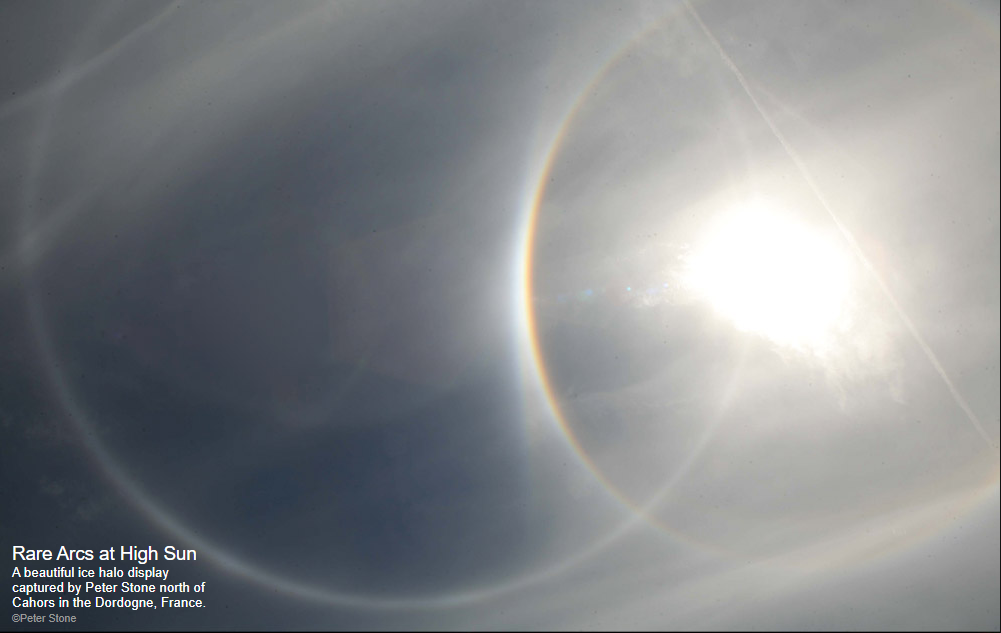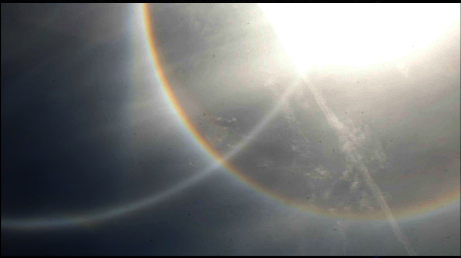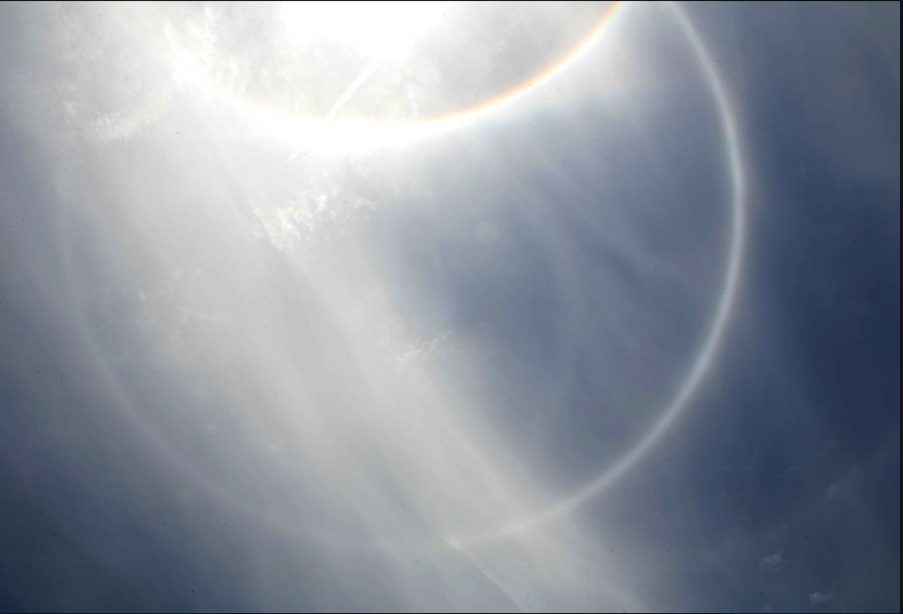OPOD - Rare High Sun Parry Arc
OPOD - Rare High Sun Parry Arc: A Phenomenon of Atmospheric Optics
Have you ever witnessed a mesmerizing ice halo display in the sky? Recently, a stunning occurrence of atmospheric optics was captured by Peter Stone in the Dordogne region of France. The images he captured showcase a rare high sun Parry arc, surrounded by a host of other intriguing phenomena. Let's delve into the details of this extraordinary event and explore the science behind it.
Understanding the Ice Halo Display
In the top wide-angle image, we observe a circumscribed halo encircling the 57° high sun. This halo is created by horizontal column crystals. Within this halo, randomly oriented ice generates a faint 22° halo. What makes this display truly exceptional are the two arcs formed by Parry-oriented column crystals. The brighter of the two arcs stretches above the sun, eventually touching the parhelic circle. In the enhanced image at the lower right, we can also discern a lower Parry arc. It's worth noting that Parry arcs are relatively infrequent, and witnessing them at high sun is even rarer.
Unraveling the Mysteries: Parry Arcs and Wegener Arcs
Parry arcs, named after their discoverer William Edward Parry, are fascinating optical phenomena that occur when sunlight interacts with ice crystals in the atmosphere. These arcs are formed by horizontally aligned column crystals. The Parry arc above the sun is particularly striking, as it reaches out to touch the parhelic circle, creating an ethereal spectacle. Additionally, a lower Parry arc is faintly visible in the enhanced image.
Another intriguing feature of this ice halo display is the presence of a rare Wegener arc. This arc loops both inside and outside the parhelic circle. Its inner loop touches the circumscribed halo above the sun, while its outer loop is tangent to the circumscribed arc beneath the sun. The Wegener arc adds an extra touch of mystique to an already captivating celestial phenomenon.
Exploring the Science Behind the Phenomenon
To gain a deeper understanding of the intricacies of this ice halo display, researchers have utilized advanced simulation tools. By employing HaloSim, a software specifically designed for modeling atmospheric optics, scientists can recreate the scene with remarkable accuracy. This simulation aids in comprehending the formation and behavior of the various arcs and halos observed in the sky.
Embracing the Rarity and Beauty of Atmospheric Optics
Witnessing such a rare high sun Parry arc is truly a remarkable experience. Atmospheric optics never fails to astonish us with its intricate displays of light and ice crystals. These phenomena serve as a reminder of the immense beauty and complexity of our natural world.
As we gaze up at the sky, we are reminded of the countless wonders that surround us. The interplay between sunlight and ice crystals in the atmosphere creates a canvas of ethereal arcs and halos, each more enchanting than the last. The rarity of events like the high sun Parry arc only adds to their allure, reminding us to cherish and appreciate the fleeting moments of natural splendor that grace our lives.
So, next time you find yourself gazing up at the sky on a clear day, take a moment to search for these celestial gems. Who knows what extraordinary atmospheric optics might unfold before your eyes?

Rare Arcs at High Sun
A beautiful ice halo display captured by Peter Stone north of Cahors in the Dordogne, France. ©Peter Stone

The top wide angle image is centered almost overhead. A circumscribed halo made by horizontal column crystals encircles the 57° high sun. Within it, randomly oriented ice generates a very weak 22° halo. A complete parhelic circle rings the zenith and passes through the sun.
The rarities are the two arcs from Parry oriented column crystals. The one above the sun is the brightest and stretches to eventually touch the parhelic circle. There is also a lower Parry arc just visible in the enhanced image at lower right. Parry arcs are infrequent - those at high sun the more so.
An added touch is the rare Wegener arc (lower image) looping both inside and outside the parhelic circle. Its inner loop touches the circumscribed halo above the sun. The outer loop is tangent to the circumscribed arc beneath the sun.
At right - the scene computed by HaloSim


Note: this article has been automatically converted from the old site and may not appear as intended. You can find the original article here.
Reference Atmospheric Optics
If you use any of the definitions, information, or data presented on Atmospheric Optics, please copy the link or reference below to properly credit us as the reference source. Thank you!
-
<a href="https://atoptics.co.uk/blog/opod-rare-high-sun-parry-arc/">OPOD - Rare High Sun Parry Arc</a>
-
"OPOD - Rare High Sun Parry Arc". Atmospheric Optics. Accessed on November 26, 2024. https://atoptics.co.uk/blog/opod-rare-high-sun-parry-arc/.
-
"OPOD - Rare High Sun Parry Arc". Atmospheric Optics, https://atoptics.co.uk/blog/opod-rare-high-sun-parry-arc/. Accessed 26 November, 2024
-
OPOD - Rare High Sun Parry Arc. Atmospheric Optics. Retrieved from https://atoptics.co.uk/blog/opod-rare-high-sun-parry-arc/.